Northern France side Lens recently tasted the fruits of their hard work by getting a promotion to Ligue 1 after an impressive season in the second tier of French football. Though their roads were a bit bumpy in 2020, they successfully maintained the runners-up spot and gained automatic promotion after the season is ended early. Head coach Philippe Montanier, however, was sacked in late February after winning only once from seven matches from fixture 20 to 26. It was a pretty harsh decision considering the former manager did a large part of the work to bring Lens up the table this season and the team played brilliantly in the first half of the season.
Though harsh, the decision taken by the board was immediately justified with reserves manager Franck Haise being appointed caretaker manager until the end of the season after Montanier’s dismissal and led Lens to two decisive wins in his first two games. The two wins brought Lens back up to second place before the season was suspended and eventually announced to be ended prematurely.
Haise, however, only made a small tactical adjustment when he took over but it’s quite clear that Montanier’s tactics and philosophy were still on display during his time at Lens this season.
In this tactical analysis, we’ll take a better look at Montanier’s tactics and philosophy during his time at Lens this season in Ligue 2.
Formations
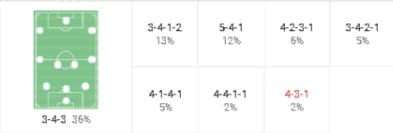
The 2019/20 season saw Montanier changing his formation preference. From favouring a back-four in a 4-2-3-1 (as well as its 4-4-1-1 and 4-4-2 variants), this season Montanier mainly preferred to use back-three formations. In the image above you can see that Montanier liked to start his team in a 3-4-3 formation which may be tweaked a little bit into a 5-4-1, 3-4-2-1, or 3-4-1-2 mid-game. Back-four formations were scarcely seen this season with Montanier using it only in the early stages in the season before then switching to a back-three formation.
Despite the change of formation preferences, Montanier’s tactics and philosophy both in and out of possession as well as in transitions are still pretty similar to last season with the team still playing high intensity and high tempo football this season.
Lens are quite dynamic this season both in and out of possession. In possession, their front three are very flexible and allowed a lot of freedom to roam around in advanced positions. Meanwhile, out of possession, they’ll usually convert to a 5-4-1 formation but their man-oriented approach in defence means that the structure can change (though usually only momentarily) depending on the opposing player’s positions.
Dominant yet also straightforward
It’s quite clear that Lens are a team that tend to dominate possession in a game. However, they’re also quite direct and vertical-oriented in possession, favouring quick straightforward attacking play rather than patiently moving the ball around and working their way forward.
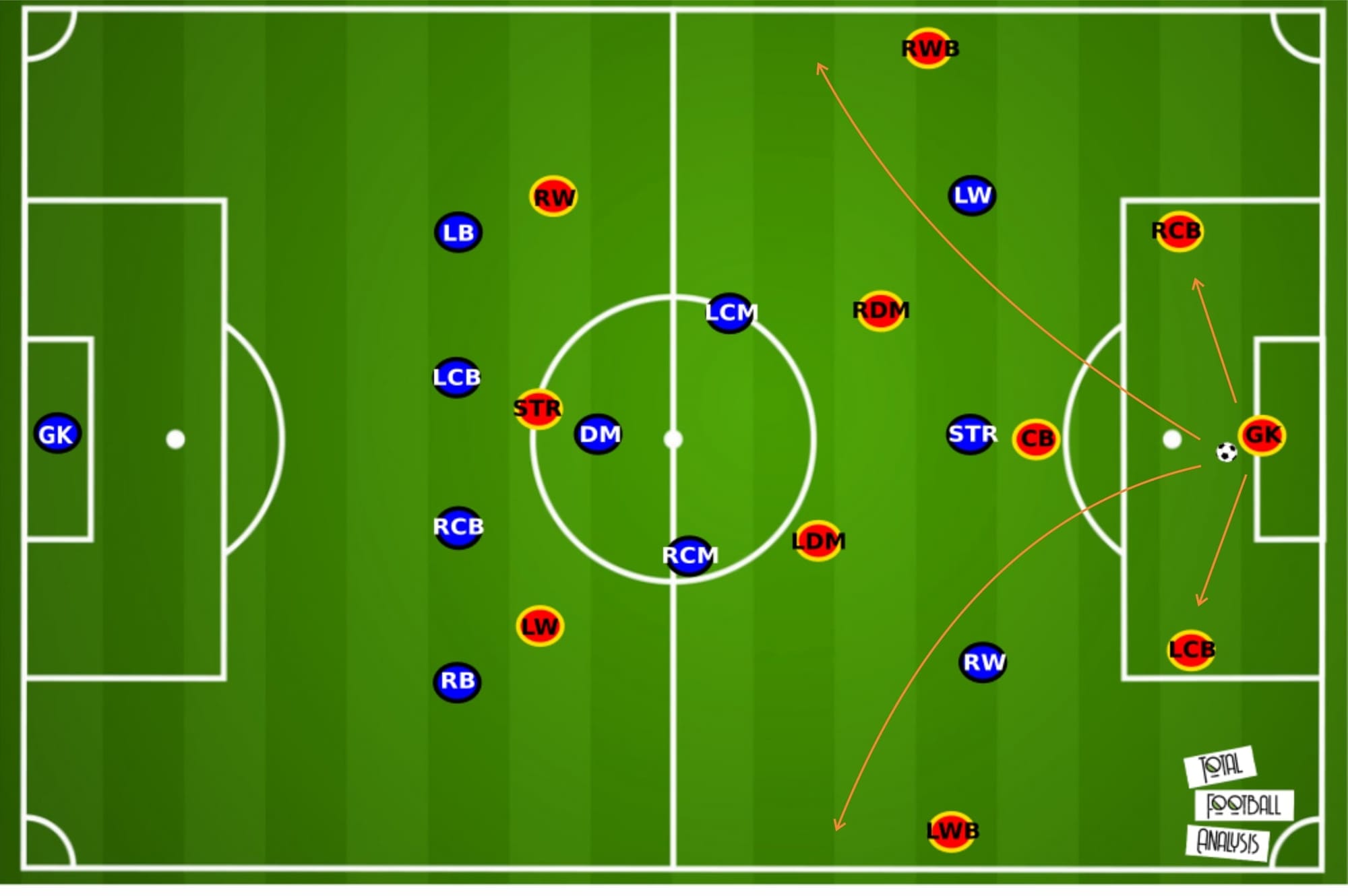
Lens’ usually try to play from the back but will quickly progress the ball forward with quick combinations as well as progressive runs and passes. If the opposing team are not very aggressive in pressing and building up from the back is deemed not risky, the goalkeeper (usually Jean-Louis Leca) will look to play short instead. He (goalkeeper) does have a few options though and doesn’t limit himself to distributing towards the nearest centre-backs, but he may also choose to play a pass towards either of the two wing-backs out wide if they’re free.
If the opposing team press high, Lens usually will try to play out of pressure but very often they can be seen playing long instead when under pressure and will look to win second balls or quickly counter-press and win the ball back upfield. Sometimes if the opposing team’s defence is compact and they can’t access players in between the lines and there are no good options nearby, a long ball may also be used to break through the opposing team’s defence.
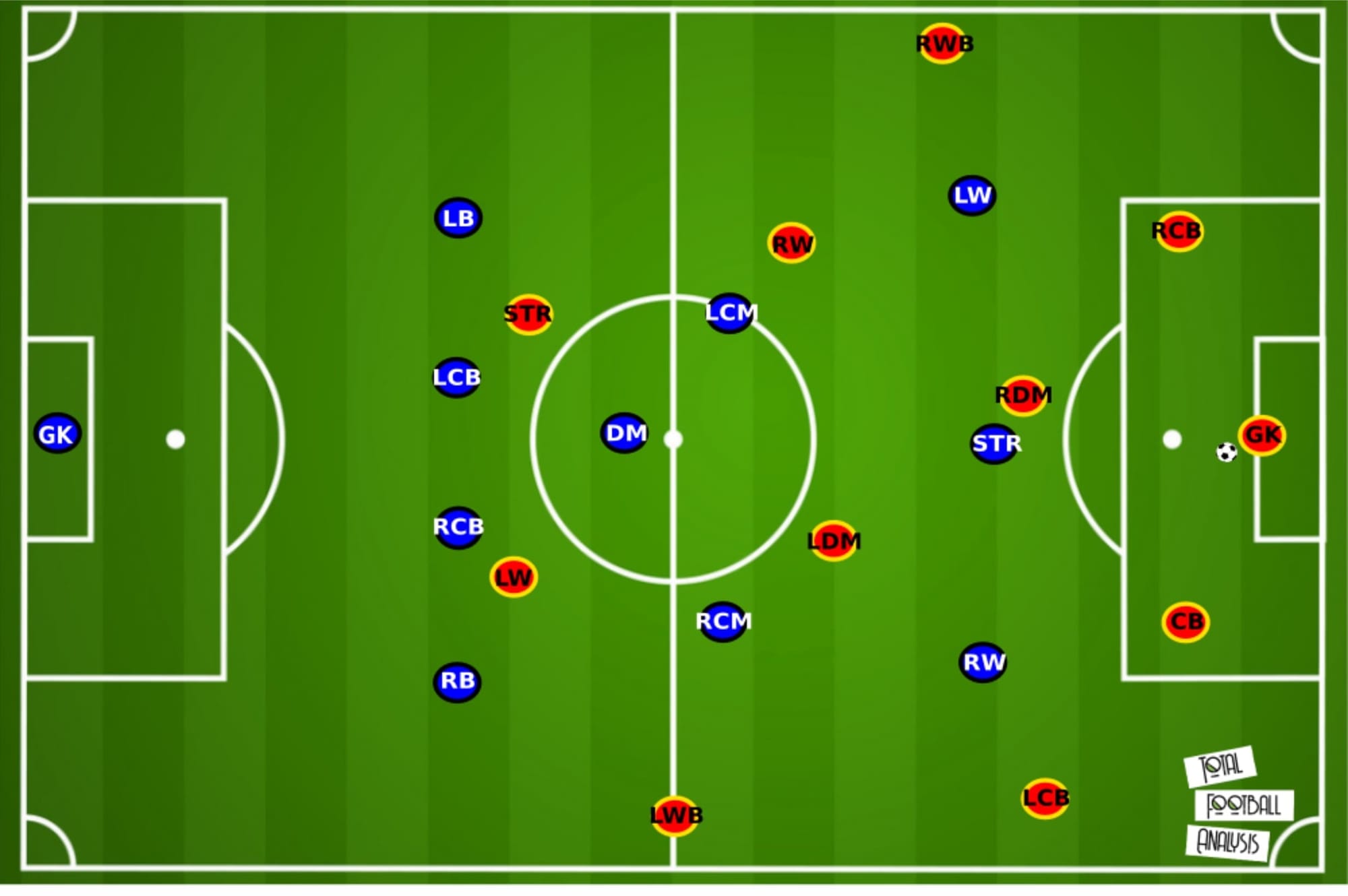
Above is another shape they may take up when in the build-up. Notice that in the first image, the middle centre-back positioned himself as if he’s a #6. He sits centrally outside of the box and occupied the opposing striker. Meanwhile, the right and left-sided centre-backs move wide to receive the pass. Meanwhile, in the second image, the middle centre-back positions himself deep instead while one of the defensive midfielders drop and one of the two centre-backs move out of the box and sit on the flank. However, aside from the shape, there’s not really a lot of tactical differences between the two starting positions though.
Lens mainly look to play through the channels with attacking players often dropping and sitting in a pocket of space in between the lines to receive the ball there. Montanier’s side are flexible when it comes to passing, not restricting themselves to short passes but also don’t rely too much on long balls. As mentioned earlier in this tactical analysis, Lens usually will try to play their way out of pressure and work their way up with quick, vertical-oriented combinations but if they don’t have good options nearby, then a long pass could be an option.
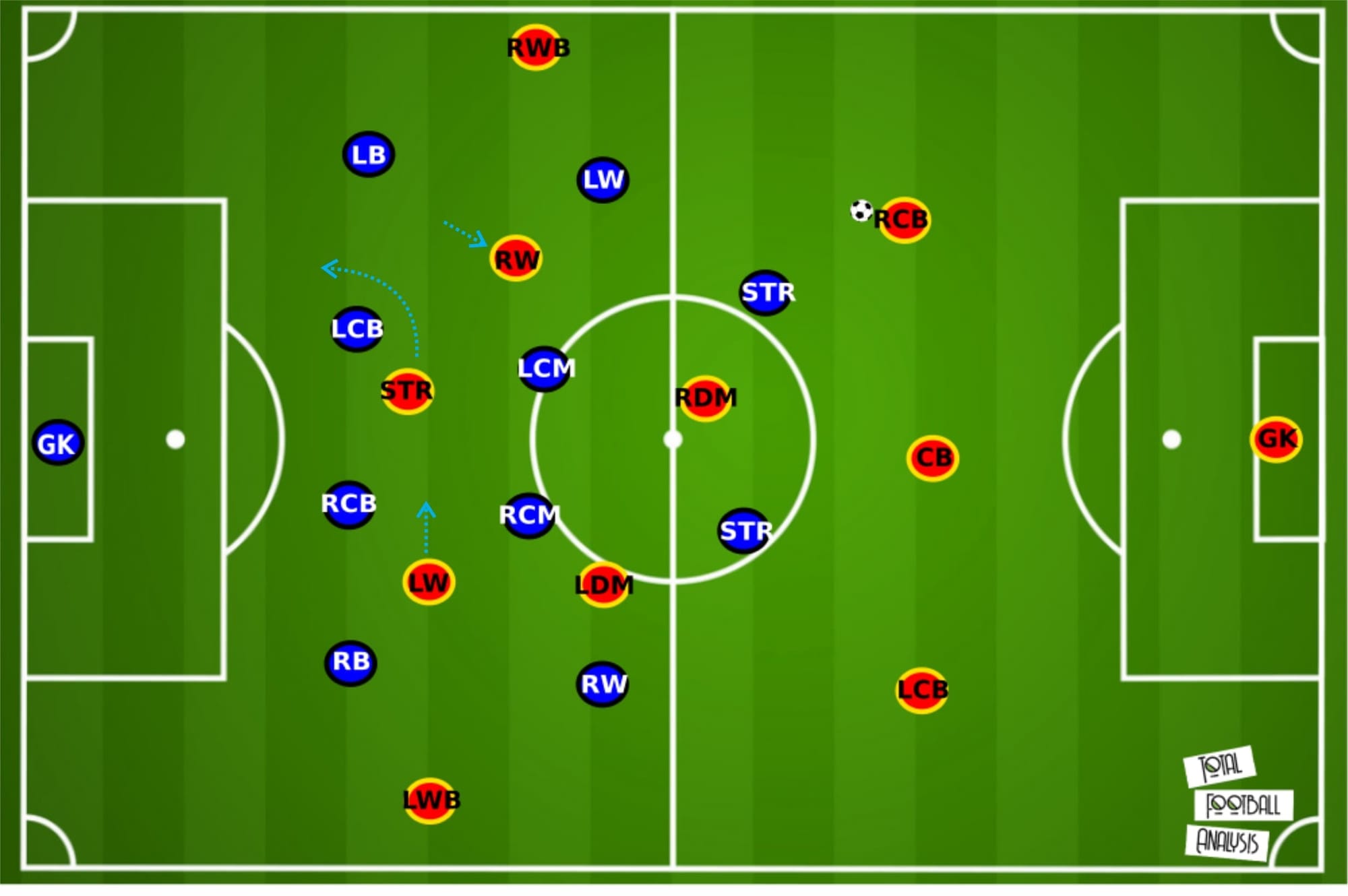
What can be seen consistently when they’re in possession is that aside from tending to play in a high tempo and direct manner, they’re also very fluid. Player movements and positioning are dynamic and flexible. Especially the front three, as mentioned in the previous section. Above you can see an illustration of Lens’ structure in the build-up. Striker doesn’t stay centrally and wingers most often occupy channels and position themselves in central areas instead of staying wide. Oftentimes, one of the wingers swaps positions with the striker to cause confusion between the opposing defenders and disrupt their structure.
Meanwhile, the wing-backs tend to sit near the touchline and stretch the opposing defence wide. They also mainly sit quite high and will drop deep only if really necessary. Usually, only one of the defensive midfielders stay deep and sit in front of the backline while the other one sits slightly higher.
Pass and move, pass and move. Players are rarely static and the overall team shape may change a little bit throughout different phases of the attack and depending on the situations. They don’t really maintain formation and players seem to be allowed the freedom to improvise with the wing-backs sometimes found occupying central areas, one of the defensive midfielders sometimes seen sitting near the touchline, or even one of the centre-backs can sometimes be seen getting further forward and combining in the final third.
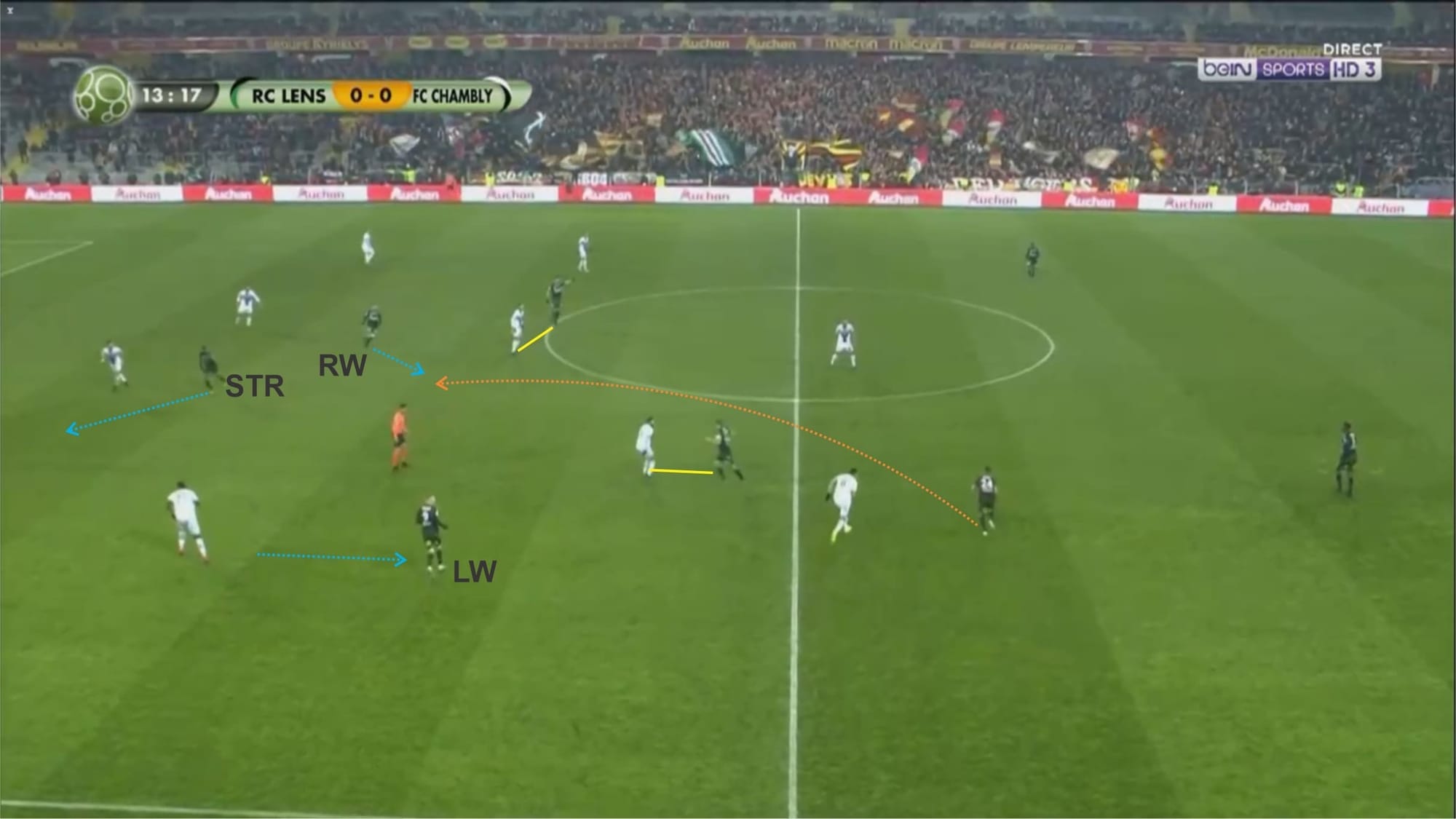
Players without the ball constantly move around to make themselves available for a pass. Some actively make runs in behind the opposing defence while some others come short, offering support and potentially dragging an opponent out of defence. Their constant and dynamic movements can cause dilemmas and force the opposing defence into thinking and making a difficult decision.
In the image above, for example, you can see that the two defensive midfielders were tightly marked (yellow line) but the two opposing markers were unaware of the Lens right-winger’s movements. Meanwhile, the striker could be seen trying to make an outward ran into the half-space, to draw his marker away from the dropping winger and allowing even more time and space for the winger to receive the ball. The nearest defender was also hesitant to follow him out and reluctant to jump to press in between the lines thus making him a very good forward passing option. However, the ball carrier didn’t make the pass towards the winger in this case and instead played it towards the centre-back on the opposite side of the pitch to switch the play.
Talking about switching play, Lens often do this to exploit underloaded areas. Though they often combine and progress through the channels, they mostly look to create chances from wide areas. And though they are direct and vertical-oriented, Lens don’t try to force their way into the opposing defence if they’re stuck. If a clean vertical progression is not possible, then the ball will be played backwards to relieve pressure and they will then witch play to restart the attack.
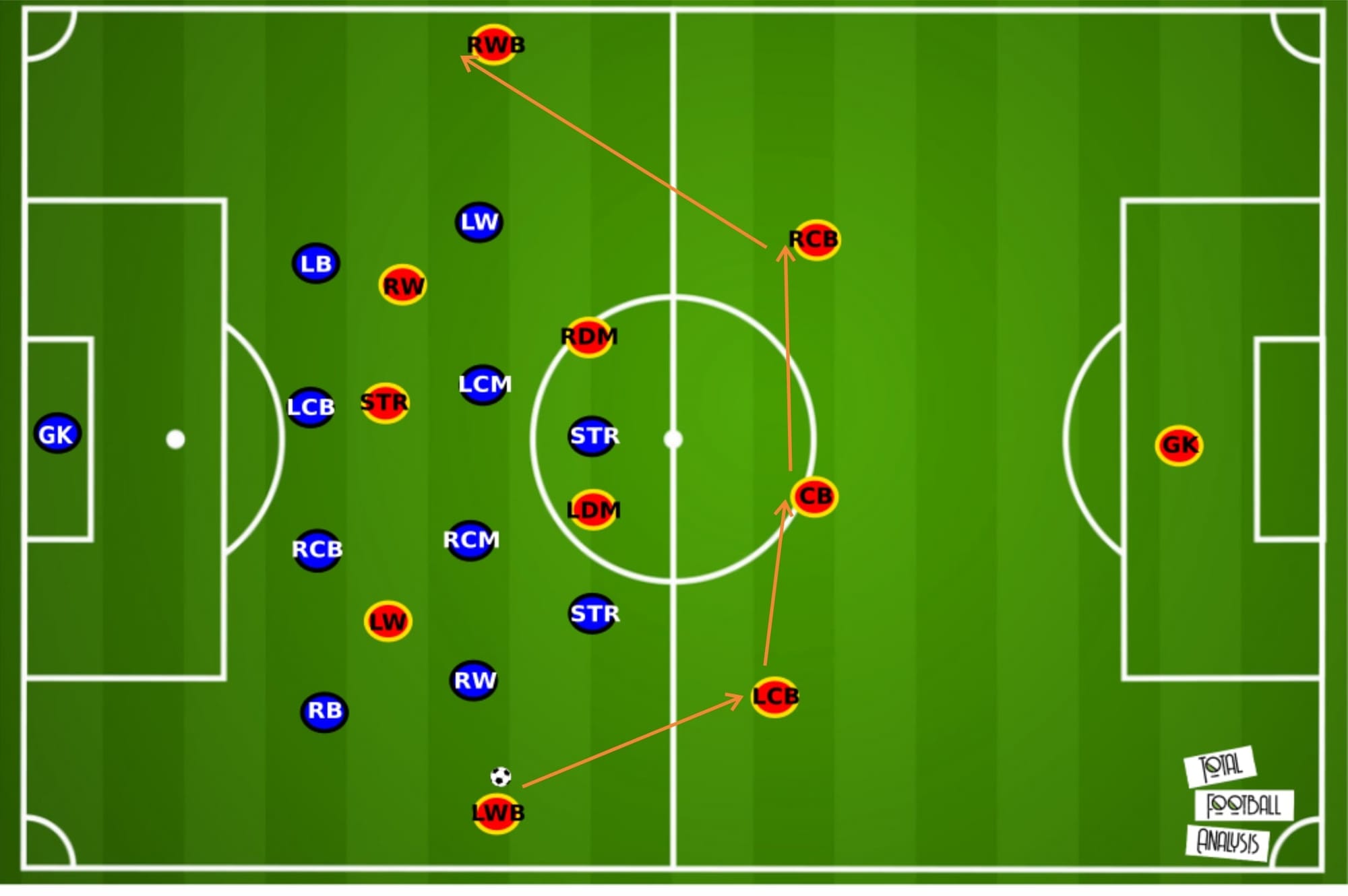
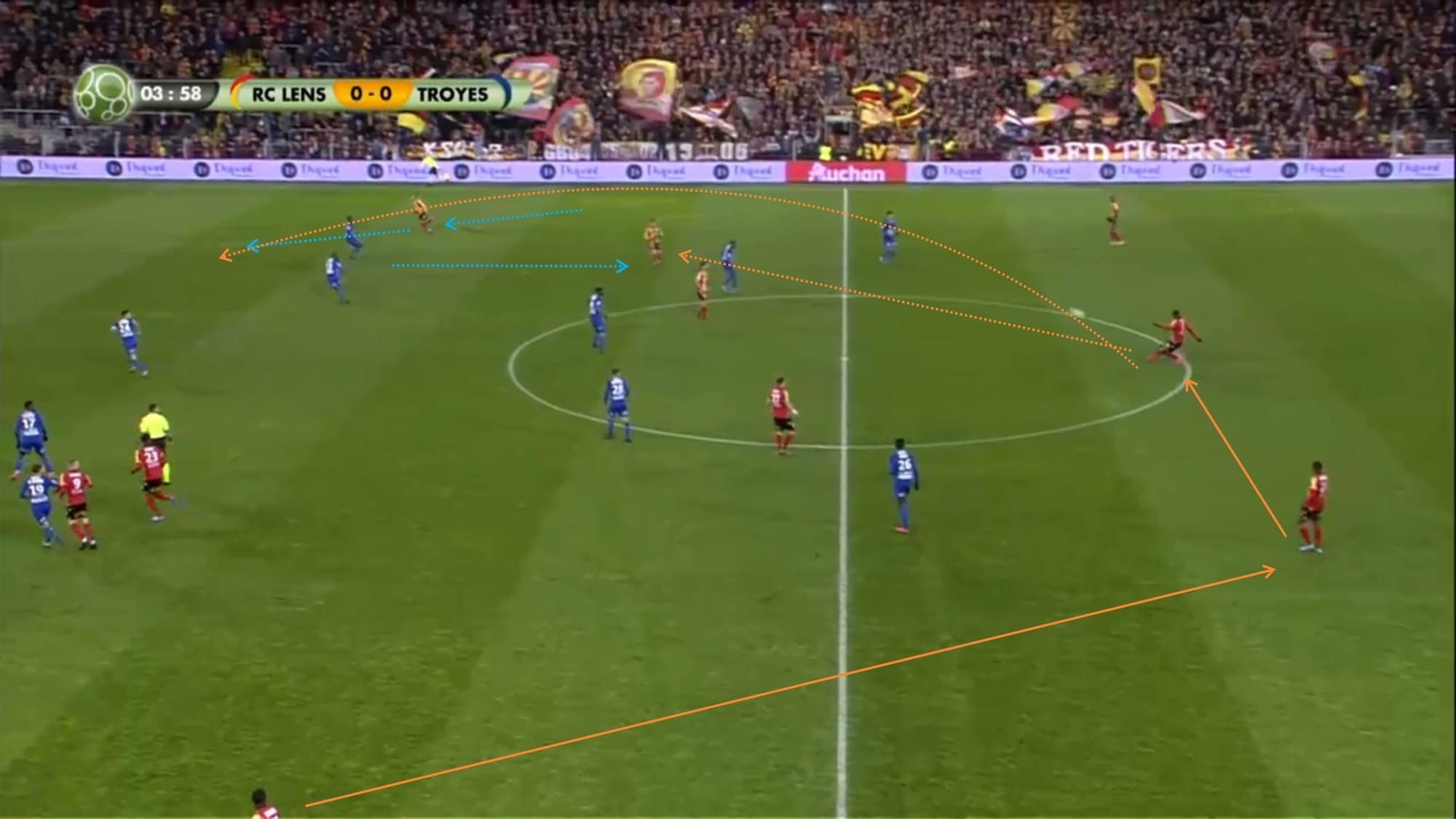
Their way of switching play may vary but the two frequently seen ways are via U-pattern passing as well as a long diagonal pass. They don’t seem to switch play often with a long lateral pass.
They mainly look to create a lot of chances from crosses. Lens are the third joint-highest team when it comes to crosses with a total of 476 crosses this season and an average of 15.93 crosses per game. The type and target of the crosses vary a lot depending on the situation, however, it can be seen that crosses from the right side are usually whipped crosses towards the main striker in the centre of the box, meanwhile crosses from the left side are often low or cutback crosses towards a late-runner, striker in the centre, or opposite winger in the far-post.
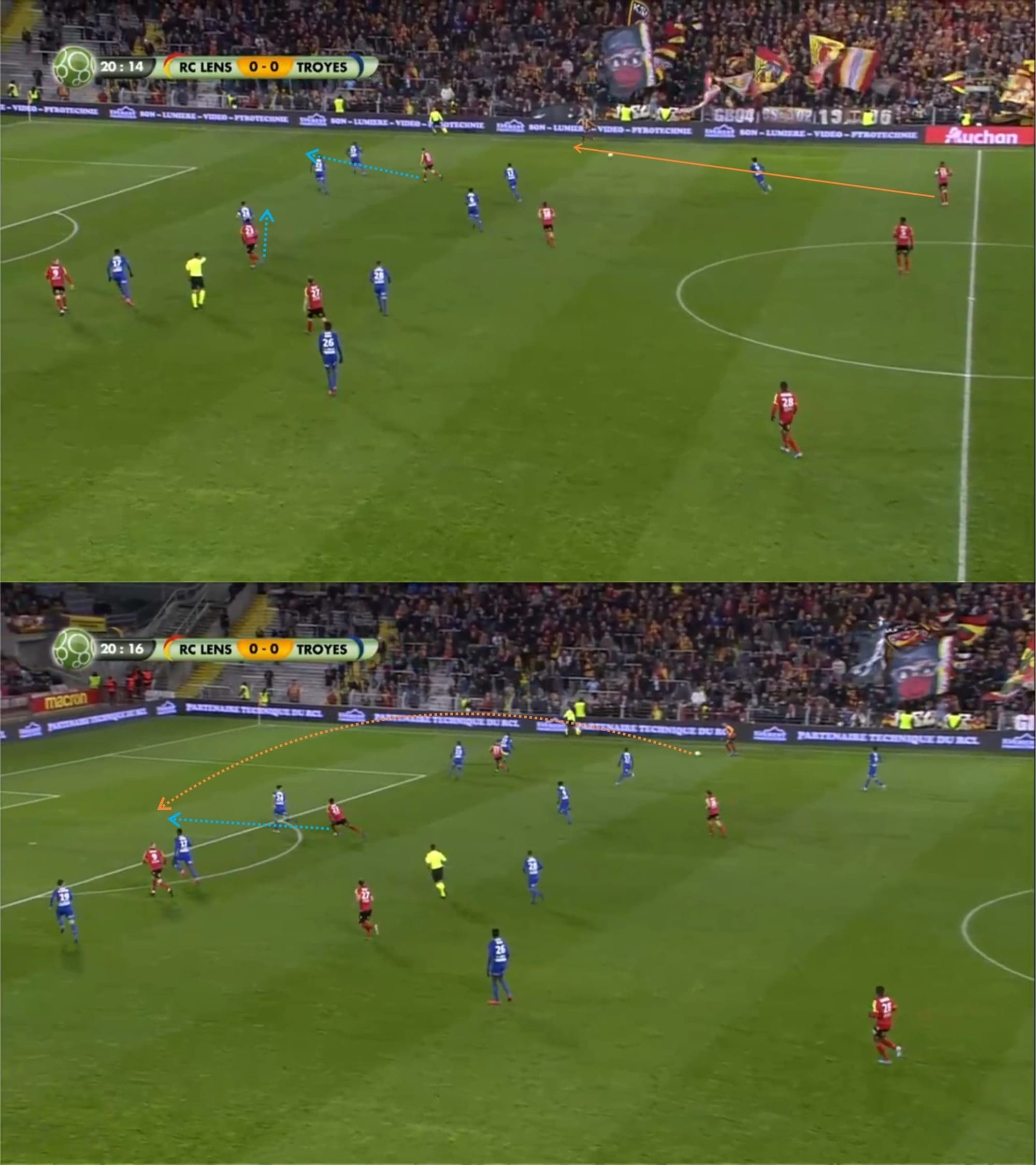
Smart movements are the key in Lens’ attack. This may look a bit subtle at first but the movements that players without the ball make can count for so much. Above, for example, Lens are starting their attack. The right centre-back played the ball towards the right wing-back. Take a look at the right-winger and striker’s movements. The right-winger looked to make a run in behind the opposing team’s defence. This run will give the opposing right-back a dilemma as he’d have to choose either to track the winger’s run or vacate his position to press the wing-back. The opposing right-back decided to sit back and not press the wing-back in this situation, giving him a lot of time and space to wait for the striker’s run and deliver a cross into the box.
Notice also the striker’s double run in the first and second image. The striker moved one way and dragged his marker with him, opening some space behind the defence. He then quickly changed directions and accelerated into the space that was created. The right wing-back already knew where to play the ball to and delivered a pinpoint cross. In this situation, the striker got his head to the ball but it hit the post and the ball was then cleared away by the opposing player.
Statistically, Lens are the third-most prolific team in Ligue 2 in 2019/20 with 39 goals scored throughout the season. Montanier’s side also ranked first when it comes to expected goals and expected goals per shot as les Sang et Or accumulated a total of 43.12 xG and 0.114 xG per shot this season. Their high xG and xG per shot indicate their ability to create high-quality chances consistently. Lens also have the second-highest amount of touches in box per game this season with 14.29 as well as second-highest deep completions per game with 6.93 indicating that the service is there and the attackers’ positioning inside the box is excellent.
Highly intense and aggressive defence
Lens are very aggressive in defence. Montanier’s side tend to defend with a high block and press high up the pitch. Their approach is quite flexible as they mainly use a mix of man and passing lane-oriented approach in defence but in certain situations and against certain opponents, they may become strictly man-oriented like in the example below.
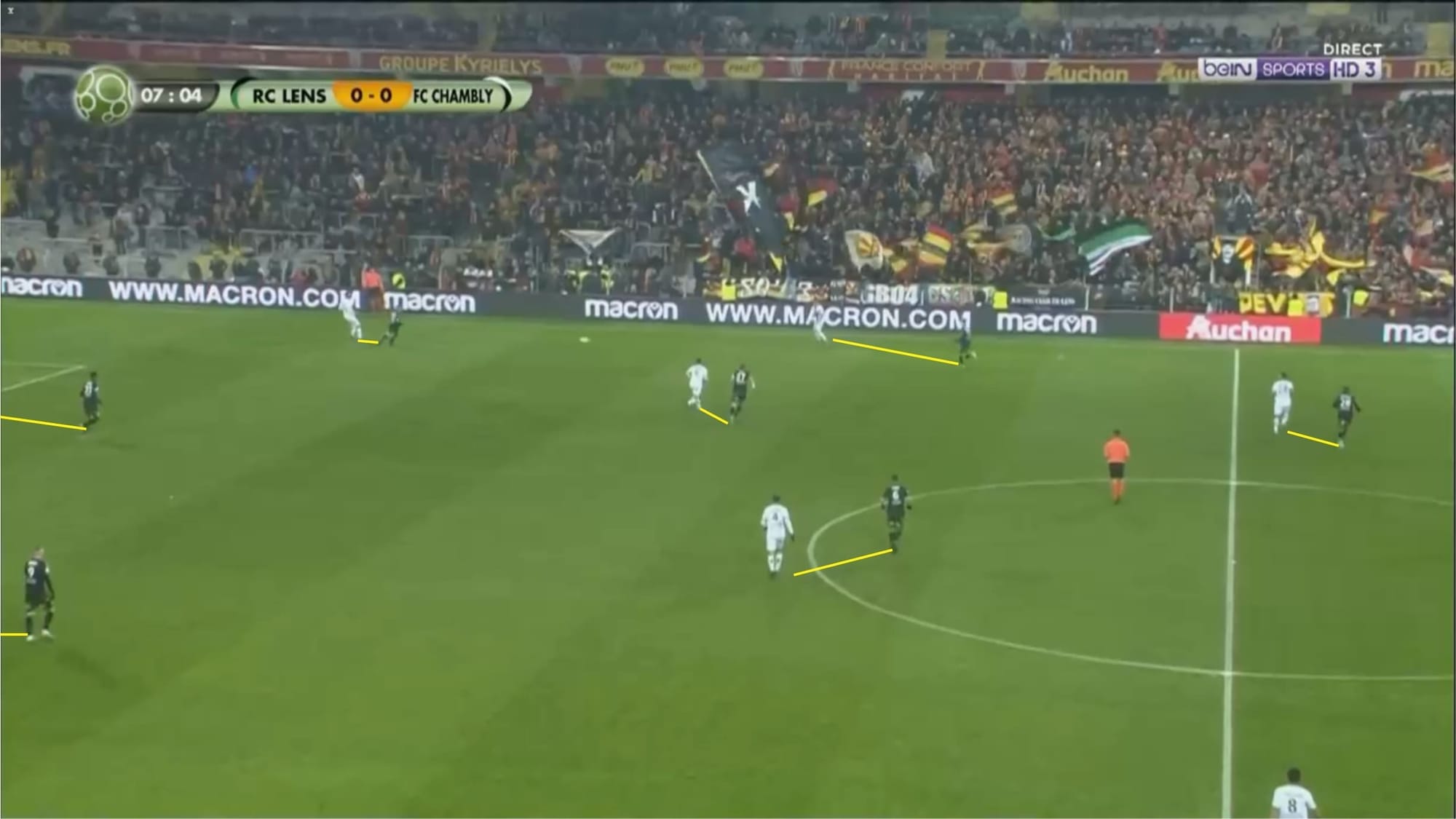
In the image above, you can see that Lens would have at least one player pressing the ball while others mark the opposing players man for man. This is possible because Chambly played with the same 3-4-3 system against Lens and they tend to maintain formation in the build-up, thus Lens were able to be man-oriented throughout the whole pitch.
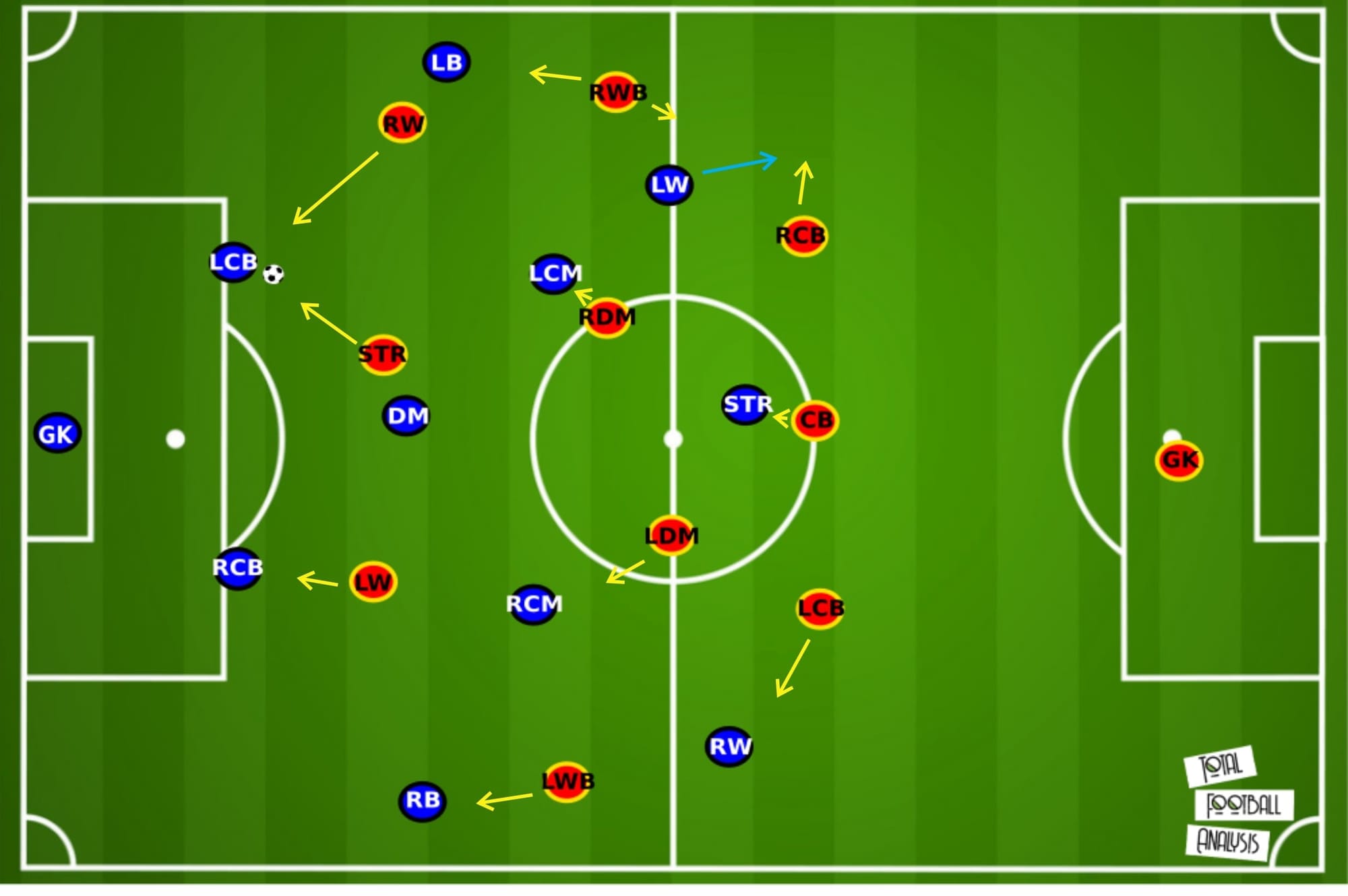
Above is an example of Montanier’s side pressing high against a 4-3-3 system. As you can see, it’s clearer in the example above their man and passing-lane oriented approach in defence. You can also see that the backline is high but they stay vertically compact. Though there’s usually not a lot of space to be exploited in front of the defence, the high backline means that they have huge space behind the defence. Despite that, with their effective and disciplined approach as well as the presence of sweeper-keeper Leca in the side, they’re usually able to deal with passes into the back of the defence accordingly. Meanwhile, with their compact block and well-structured defence, Lens are usually also able to deal with passes into the front of the backline/in between the lines by triggering pressing traps to recover the ball or win second balls.
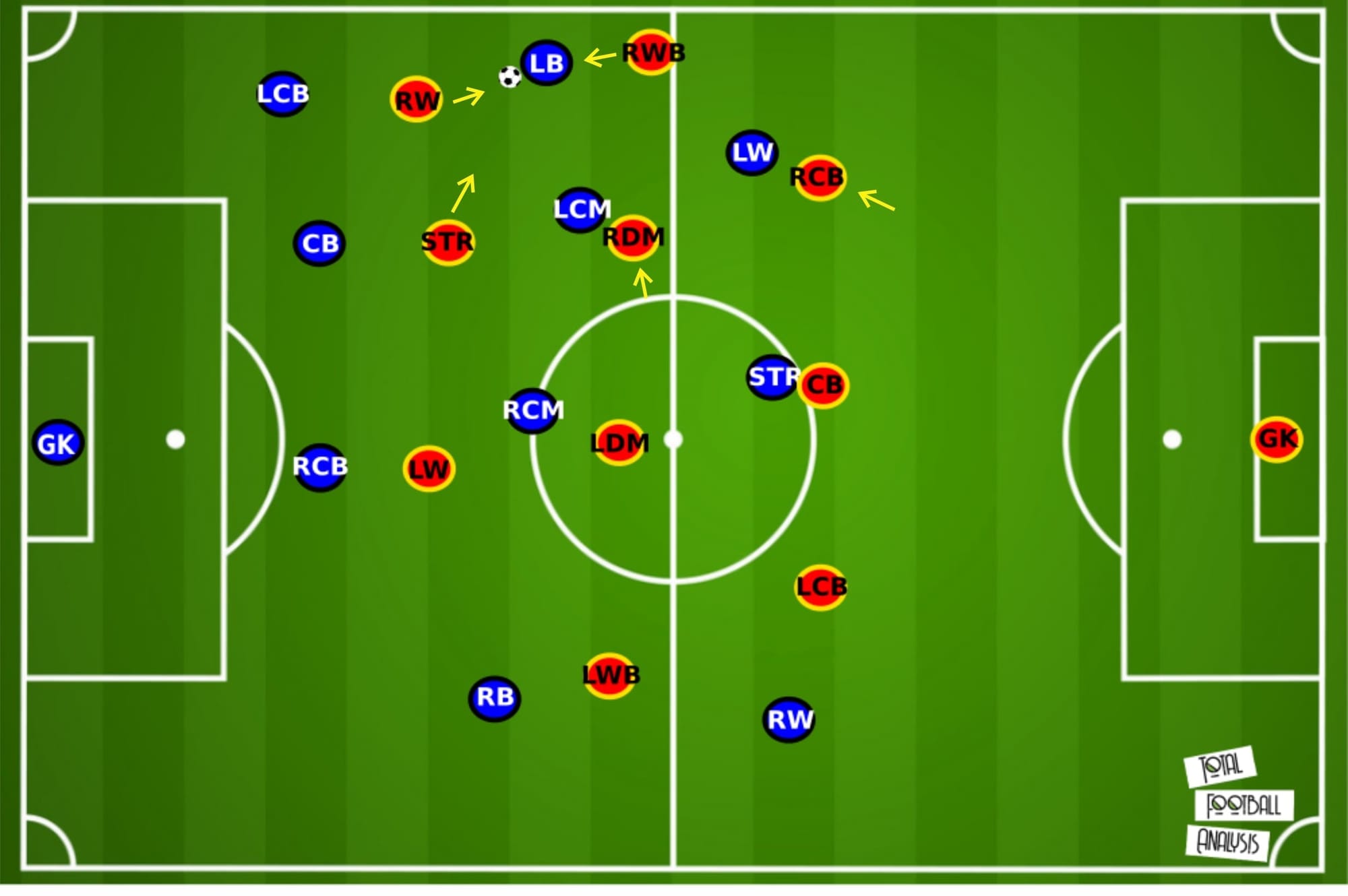
Above you can see Lens defending against a 5-4-1/3-4-3 system. Once the ball is played by the opposing left centre-back towards the left-back, players quickly collapse onto the ball and overloaded that area. With near options marked and passing lanes cut off, the opposing ball-carrier has nowhere to go and is effectively isolated. The same thing can be seen if the ball is also played inside the block in central areas.
Lens’ goal in their high press, however, is not just to block the opposing team’s access and prevent progression or to force them to play long. But they also seek to win the ball very high up the pitch. This can be seen with attackers tending to engage the ball carrier in a duel and actively commit tackles to win the ball. This results in a high amount of defensive duel numbers for the attackers, especially the wingers.
Right-winger Tony Mauricio, for example, averages 6.29 defensive duels per game while left-winger Gaetan Robail is even more active with 7.46 defensive duels on average per game this season. Strikers Simon Banza and Florian Sotoca also have a decent average of defensive duels per game this season with 3.04 and 3.34 respectively. Compared to French giants Paris Saint-Germain, right-winger Ángel Di María averages only 3.64 defensive duels while Neymar is slightly higher with 4.37 defensive duels per game. Former Inter striker, Mauro Icardi, on the other hand, registers an average of 1.5 defensive duels while his usual partner, Kylian Mbappé has an average of 2.03 defensive duels per game. The numbers above show the different tendency and philosophy that both teams have despite both teams looking to press high up the pitch and using a mix of man and passing lane-oriented approach.
Stats-wise, Lens also rank first when it comes to PPDA with only 8.09 PPDA per game, right above Ajaccio with 8.37 per game. They’re also first in Wyscout rankings when it comes to challenge intensity with 6.9 defensive actions made per minute of opponents’ possession, while Ajaccio are second with 6.8 indicating Lens’ high aggression and tendency to get stuck in to win the ball. The Lensois’ numbers are even higher than PSG’s 6.6 defensive actions made per minute of opponents’ possession in Ligue 1 this season but again, the two teams have different philosophies despite similar tactics and style in defence.
Quick and effective counter-pressing
Perhaps another factor that contributed to Lens’ dominance in possession is their tendency to not allow the opposing team to have the ball. They press high and are very intense and aggressive in defence. They are direct and calculated in possession. And when they lose possession, they’re quick to press and limit the opposing team’s passing options. Again, they have pretty much the same tactics and philosophy as in their high press. This can also be seen as their main goal in counter-pressing is to win the ball, not only to delay the opposing team’s counter-attack.
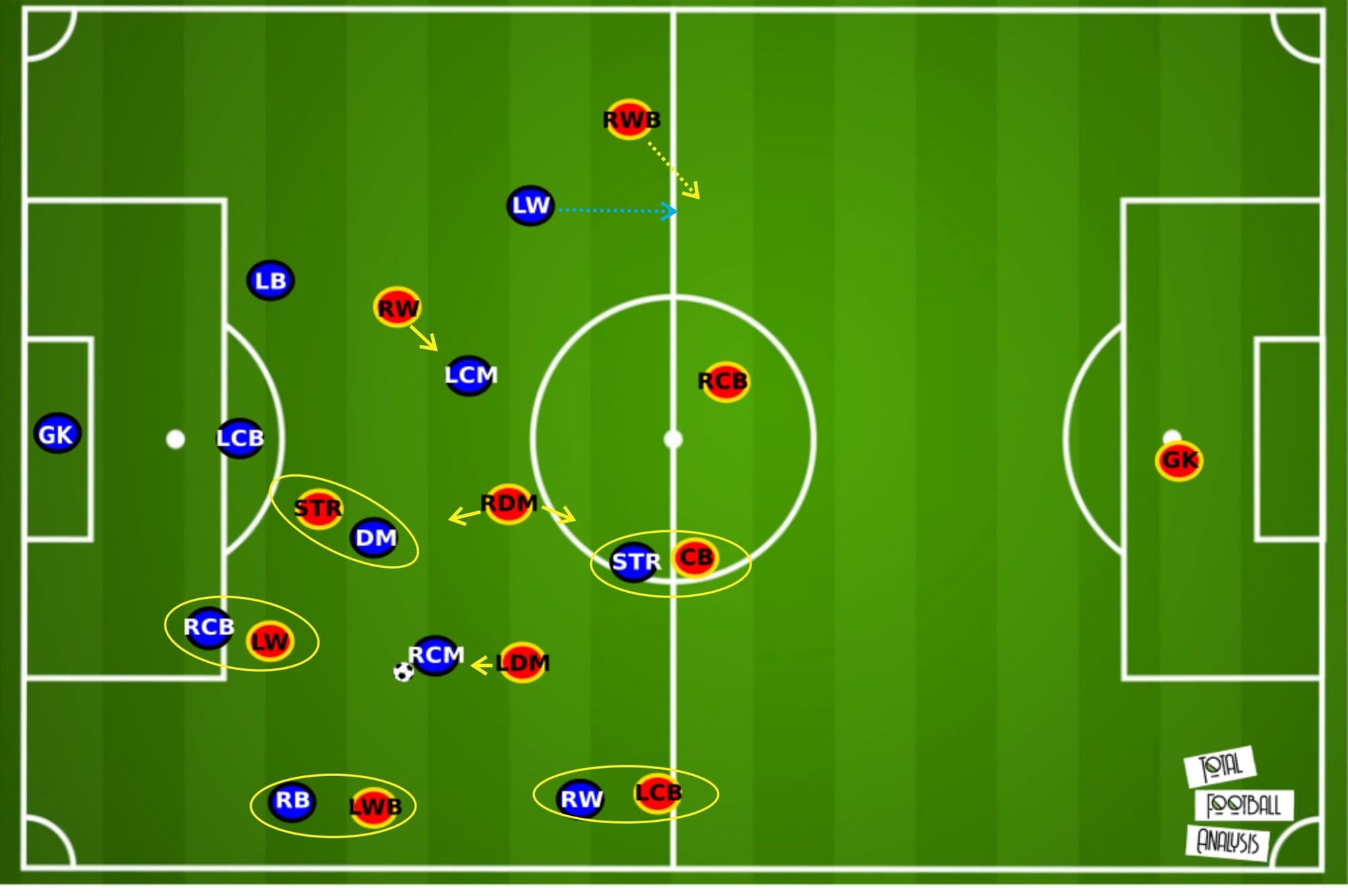
Above you can see Lens losing possession and then counter-pressing the opposing team. Lens usually have only three players in rest defence (the three centre-backs). Sometimes even only two if one of the centre-backs joins the attack. However, they’re well-structured and disciplined, thus making their counter-press highly effective although risky.
Again, they combine man and passing lane-orientation to limit the ball carrier’s options and isolate him. They’ll usually have one or two players pressing the ball while others mark the near options or mark the passing lanes. They are very aggressive and instead of sitting back, usually one of the centre-backs will also push forward to mark his man, taking a risk by vacating his position.
The risk, however, is high and if the counter-press is not executed properly, Lens can be very vulnerable.
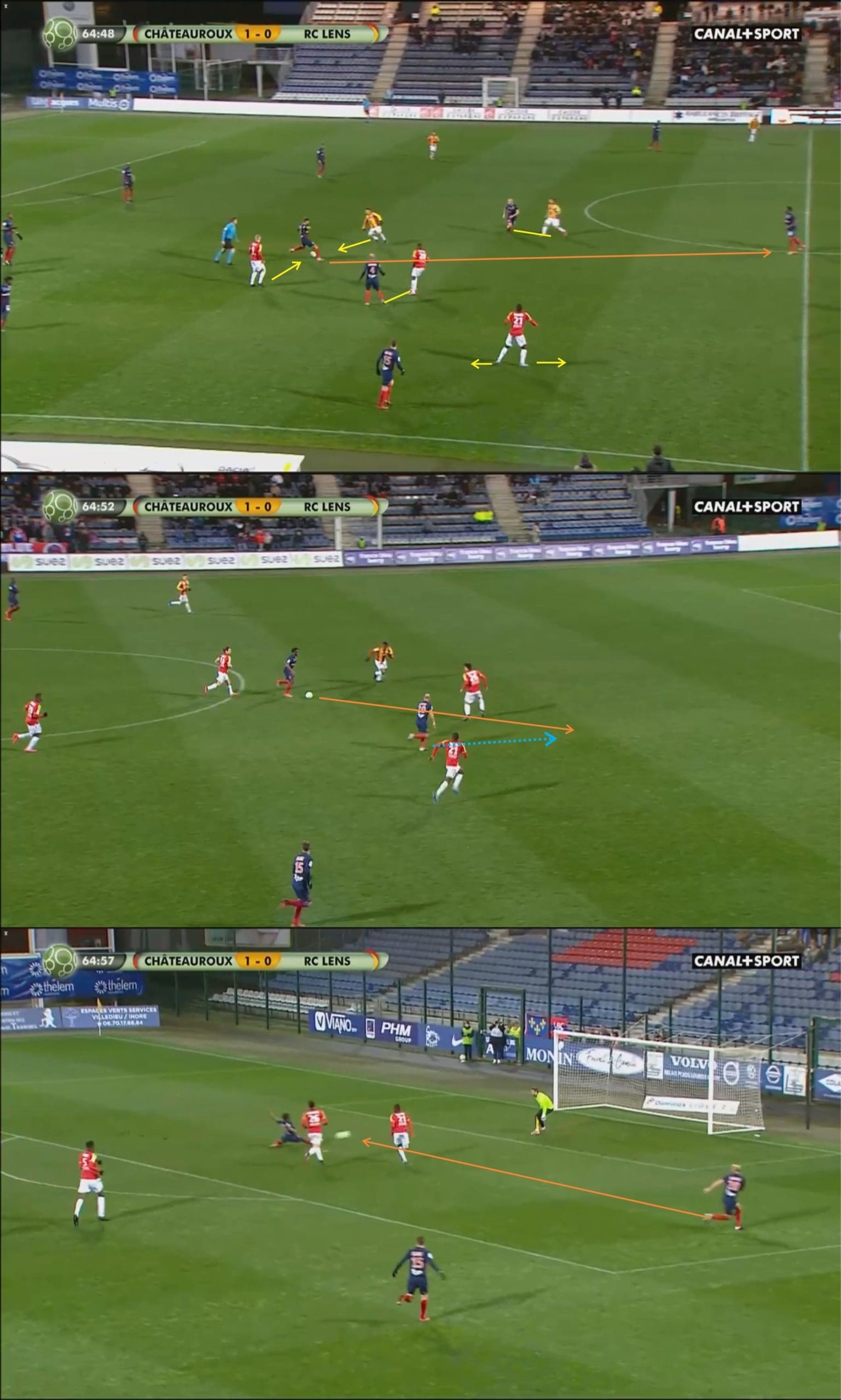
Above, for example, Lens just lost the ball in an advanced position and they tried to counter-press to win the ball back high up the pitch. However, their preparation for the press was poor and not all of the passing options/lanes were marked. The pressers also reacted slowly and were not aggressive enough to the ball carrier, allowing him time to receive the ball, look up, and play the forward pass. In the first image above, Cheick Fantamady Diarra (Châteauroux striker) dropped but none of the two nearest Lens centre-backs stayed tight with him with Aleksandar Radovanović hesitant to jump out to press while Zakaria Diallo seemed intent on sitting back and covering the space. The communication from the two players was poor. Diarra played the ball through into space in front of teammate Alexandre Raineau who drove forward with the ball before releasing a low cross for Diarra to finish. Lens certainly should have been able to stop the counter-attack but a series of mistakes due to poor communication as well as lack of awareness cost them dearly and this has happened quite often this season.
Conclusion
Though it was Haise who sealed the deal and clinched the promotion to Ligue 1 this season, Montanier’s work and influence in the team (especially tactically) simply cannot be neglected. The man who used to manage La Liga side Real Sociedad and EFL Championship club Nottingham Forest has had his fair share of struggles when managing a team but he has proven in the last two seasons with Lens that he’s an intelligent tactician who can work with limited resources.
As of now, there doesn’t seem to be any concrete news or rumours regarding where he’ll eventually move to but it will be interesting to follow his career and see him (and his next team) in action in the future.





Comments